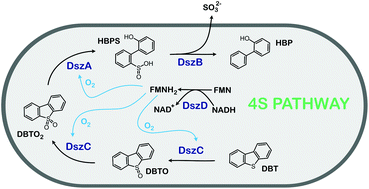The bacterial 4S pathway – an economical alternative for crude oil desulphurization that reduces CO2 emissions†
Abstract
The migration of energy production from environmentally hazardous methods to greener methods, exploring renewable sources, is one of the main goals of humanity for the XXI century. Nonetheless, our society is still largely dependent on fossil fuels for the majority of its key activities and will still be for the foreseeable future. This dependence urges the finding of ways to mitigate the environmental impact of the usage of fossil fuels, in particular oil. Sulphur compounds present in crude oil are one of the leading causes of the harmful environmental effects caused by its combustion. For this reason, increasingly lower concentrations of sulphur compounds are demanded, at the governmental level, on the refined oil. Unfortunately, the desulphurization of crude oil, which is currently achieved by chemical hydrodesulphurization, also presents harmful environmental effects. Thus, cleaner methods for desulphurizing crude oil are also needed. Currently, the most promising, with little environmental impact, desulphurization method is the biodesulphurization procedure called the ‘4S pathway’ carried out by three enzymes of the dszABC gene cluster encoded in the plasmid of the bacterium Rhodococcus erythropolis. In addition, a chromosome encoded flavin reductase (DszD) supplies FMNH2 to the flavin-dependent enzymes of the pathway. Unfortunately, the 4S pathway is not currently attractive for industrial application, due mainly to the low kinetic efficiency of the enzymes that compose it. Therefore, we urgently need to find ways to enhance the 4S pathway, turning it into a viable complement to the current methods of desulphurization of crude oil. In this review, current methods of desulphurization of crude oil are discussed, and the state of the art of the 4S pathway is analyzed. We point out directions and strategies to improve the efficiency of biodesulphurization, to make it attractive and profitable at an industrial scale.



 Please wait while we load your content...
Please wait while we load your content...